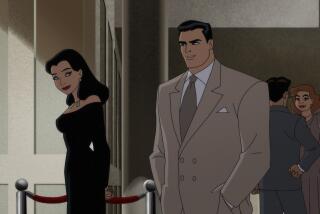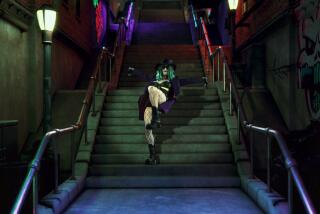The complicated, controversial history of ‘Batman: The Killing Joke’
On July 25 and 26, Warner Bros. Animation’s “Batman: The Killing Joke” — based on the 1988 graphic novel written by “Watchmen’s” Alan Moore with career-defining artwork by Brian Bolland — played in 1,325 theaters across the country, grossing $3.7 million. The $3.1 million it made on its first day was enough to outgross “Ghostbusters,” “Lights Out” and “Ice Age: Collision Course,” films that all benefited from the kind of full-court marketing press that studios can mount.
The reasons why the animated film — the first Batman cartoon to hit theaters in more than 20 years — performed so well are complicated, and they speak to the complicated history of its source material.
DC Entertainment’s “Batman: The Killing Joke” is, arguably, the most controversial comic book featuring Batman in the character’s 75-plus-year history. Ostensibly a story that intertwines an attempt by the Joker to break the will of Police Commissioner Gordon with a retelling of the Joker’s origin story, it has become something altogether different in the years since it was originally published: a Rorschach test about gender politics and sexualized violence in superhero comics, thanks to its treatment of Barbara Gordon, a.k.a. Batgirl.
That wasn’t the subject foremost in anyone’s mind when work started on the book. Originally, the project was intended to showcase the work of Bolland, a British artist whose work on “Judge Dredd” and an earlier DC series, “Camelot 3000,” had turned heads and won awards. Asked about his dream project by editors, he asked for his favorite writer, Moore, writing a straightforward Batman versus the Joker story.
The combination was likely an exciting one to the publisher. By the mid-1980s, Moore was a rising star at DC thanks to his award-winning run on horror series “Swamp Thing” and the soon-to-be-classic “Watchmen,” while Batman was once again a character being taken seriously by fans and critics alike in the wake of Frank Miller’s just-published “Batman: The Dark Knight Returns.” Add these two elements with the buzz surrounding Bolland’s intricate artwork and the project must have seemed like a can’t-lose scenario.
Certainly, when the book was published, it was a success. Described by comic book historians Robert Greenberger and Matthew K. Manning as “the definitive Joker story of all time,” “The Killing Joke” was cited by Tim Burton as one of the main influences on his 1989 “Batman” movie and by Heath Ledger as a reference point for his performance in 2008’s “The Dark Knight.”
Critical praise for the book centered on the underpinnings of Moore’s story. In his 2002 book “How to Read Superhero Comics and Why,” academic Geoff Klock praises “The Killing Joke’s” metatextual elements, arguing that the book “shows both the terror and the particular joyfulness of living within a fictional world burdened by an insanity of signification.” A 2005 reappraisal of the book from IGN.com described the title as “an examination of human nature,” going on to call it “a masterfully told story” and add that “if you haven’t read ‘The Killing Joke,’ you have no right to call yourself a Batman fan.”
So what changed?
“The Killing Joke” was published at a time when the idea of the “realistic” superhero was on the rise as the comics industry struggled to reach new readers — “DC Comics aren’t just for kids!” exclaimed one cover tagline of the period — and it’s a book that readily embraces that concept by turning the Joker into a more sadistic, crueler character than he had ever been before.
This came to a head in a scene where the Joker confronts Commissioner Gordon’s daughter, Barbara — who, although it’s not mentioned in the book itself, is secretly the superhero Batgirl — and shoots her in the gut, shattering her spine. As he then bends down to unbutton her blouse, he tells her, “I’ll take some snapshots to remind him of you.” In a later scene, the reader sees that he’s carried through on his threat: the backdrop of one scene is a number of photographs of a naked Barbara, writhing in pain.
At time of publication, the scene was, if not embraced, then at least accepted as a signifier of the Joker’s evil. Before too long, however, the response had become one of concern over the treatment given to one of DC’s most high-profile female heroes, left crippled and sexually abused to provide emotional pain for the story’s male protagonists.
The implicit misogyny in DC’s treatment of Batgirl was underscored by Moore himself, whose relationship with the publisher had soured in the years since publication. In a 2006 interview with Wizard magazine, he recalled that “I asked DC if they had any problem with me crippling Barbara Gordon — who was Batgirl at the time — and if I remember, I spoke to Len Wein, who was our editor on the project. … [He] said, ‘Yeah, OK, cripple the bitch.’”
Any reading of DC’s corporate culpability in the treatment of Batgirl is complicated by comparing Bolland’s original artwork — leaked online in 2013 — and the printed book, however. A comparison of the scene where Barbara’s photographs are shown reveals that someone at DC altered artwork to remove a shot of Gordon crying at the reader with her breasts on full display. On his personal blog, Bolland responded to the release of the original artwork by saying, “I drew what was in the script. That’s my job. I was asked to tone it down a bit.”
Whoever was responsible, it doesn’t alter the fact that “The Killing Joke’s” current reputation comes almost entirely from its treatment of Barbara Gordon — one of only two female characters in the entire book, the other being the Joker’s unnamed wife, seen only briefly in flashbacks. Moore himself has turned against the work, saying in one 2000 interview that it “put far too much melodramatic weight upon a character that was never designed to carry it” and describing it as “too nasty … too physically violent.”
Subsequent comic book creators would also reject the work. Within two years of “The Killing Joke’s” publication, writers John Ostrander and Kim Yale had revived Barbara Gordon as “Oracle” — a self-sufficient wheelchair user who became an information broker to the superhero community — in the pages of the “Suicide Squad” comic book. Oracle would, in time, become a favorite of fans and comic book creators alike, growing increasingly central to DC’s fictional universe and providing much-needed visibility for differently-abled characters in the traditionally able-bodied superhero genre; the Oracle concept is commonly used as a defense for “The Killing Joke’s” treatment of Batgirl.
In 2011, Gordon’s disability was done away with together as she returned to action as Batgirl, and in 2015, creators of the “Batgirl” comic implied that at least parts of what had been seen in “The Killing Joke” had never actually happened to the character at all, a move that was greeted with much excitement from a vocal fan base. “You changed things. You beautiful humans,” read one response on Twitter.
And yet “The Killing Joke” persists.
Part of the reason for that is simply a matter of business. As DC copublisher Dan DiDio told the media at this year’s San Diego Comic-Con, “The Killing Joke” had been DC’s top-selling title in the bookstore market for the last two years, more than a quarter of a century after its original appearance, despite no specific promotional push for the title. Clearly there’s a hunger for the material, and it’s a hunger that, in most circumstances, any publisher would be eager to feed.
In practice, however, that has proved to be difficult to accomplish. Last year, an alternate cover for the “Batgirl” series that featured the title character held captive, crying, by the Joker in his “Killing Joke” outfit was pulled at the last minute following complaints not only from fans but from the creators of the comic, who said publicly that it didn’t match the tone of their work. Anger over the cover led to its artist, Rafael Albuquerque, receiving death threats online.
At Comic-Con, the first public screening of the animated adaptation of the book ran into even more controversy thanks to the addition of a new subplot that was poorly received in which Batman and Batgirl are having an affair, complete with a sex scene between the two. The negative reception was hardly the home-run reaction that might have been expected from the core fan crowd in attendance. Even the critics appear split: On Thursday, “Batman: The Killing Joke” was balancing a 50% on Rotten Tomatoes.
Executive producer Bruce Timm was prepared for a bumpy ride, telling the Los Angeles Times ahead of the screening that “there are some uncomfortable things about [the adaptation], there are things that you can’t really get behind and go, ‘Yeah, I want to see more movies about women being mutilated and stuff,’ but not every story needs to be non-problematical.”
That last sentiment might be the essential part of the conversation surrounding “The Killing Joke” today. At a time when the demographics of the comic book industry are shifting away from the aging white male stereotype, the continued success of this story is a reminder of an era that many would rather forget — a time when superhero comics culture wasn’t the world of a “Wonder Woman” movie or all-ages “DC Super Hero Girls” program, but one where women were predominantly props to be used to spur the men into action.
Yet, if “The Killing Joke” doesn’t represent what could now be considered the future of superheroes — a genre inclusive and inviting to all audiences — its continued success in bookstores, and now at the box office, highlights a growing schism at the heart of superhero fandom as to what that future will actually look like and demonstrates how important the material remains today, albeit for very different reasons than when it first appeared.
ALSO
‘Batman: The Killing Joke’ stuns with $3.8 million in two-day-only theater run
Ben Affleck confirmed as director, star of solo ‘Batman’ movie
First ‘Justice League’ trailer is a massive change in tone for Batman
More to Read
The biggest entertainment stories
Get our big stories about Hollywood, film, television, music, arts, culture and more right in your inbox as soon as they publish.
You may occasionally receive promotional content from the Los Angeles Times.










